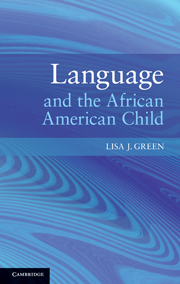Book contents
- Frontmatter
- Contents
- Figures
- Tables
- Foreword
- Preface
- Note on the text
- 1 Child AAE: an introductory overview of the data and context
- 2 Characterizing AAE: feature lists, dual components, and patterns and systems
- 3 System of tense–aspect marking 1: non-past and habitual
- 4 System of tense–aspect marking 2: past time
- 5 Negation: focus on negative concord
- 6 Asking questions: seeking clarification and requesting elaboration
- 7 Variation: intra-dialectal/variable-shifting and inter-dialectal/code-shifting
- 8 The D.I.R.E.C.T. Model: linking linguistic description and education
- Appendix A: List of participants
- Appendix B
- Notes
- References
- Index
3 - System of tense–aspect marking 1: non-past and habitual
Published online by Cambridge University Press: 05 June 2012
- Frontmatter
- Contents
- Figures
- Tables
- Foreword
- Preface
- Note on the text
- 1 Child AAE: an introductory overview of the data and context
- 2 Characterizing AAE: feature lists, dual components, and patterns and systems
- 3 System of tense–aspect marking 1: non-past and habitual
- 4 System of tense–aspect marking 2: past time
- 5 Negation: focus on negative concord
- 6 Asking questions: seeking clarification and requesting elaboration
- 7 Variation: intra-dialectal/variable-shifting and inter-dialectal/code-shifting
- 8 The D.I.R.E.C.T. Model: linking linguistic description and education
- Appendix A: List of participants
- Appendix B
- Notes
- References
- Index
Summary
Akila: ’Cause when I watch Blues Clues, my eyes be like this. <makes blinking motion with eyes>
Introduction
This chapter addresses some of the features and properties in the system of tense–aspect marking in child AAE. Tense refers to the time of an event, whether it takes place before, after, or during the speech time. For instance, we refer to past time or time prior to the moment the sentence He left is uttered, such that the leaving event took place before now or before the speech time. Aspect refers to other properties of events, such as whether the event occurs occasionally, whether it is represented as being in progress, or whether it is represented as being a complete event. An example of an aspect in general English is the progressive, as in running, which represents the running event as in progress or ongoing. The sequence is running indicates that the running event is in progress at speech time, present progressive, and the sequence was running indicates that the running event was in progress before speech time, past progressive. Specific tense–aspect marking has also been observed in child AAE. One of the issues in this chapter concerns the relationship between overt markers in the form of verbal elements (words), suffixes, or contracted forms and the tense–aspect meaning of sentences. To what extent do children use separate markers to indicate that an event is in the present or non-past, or that the event occurs on occasions?
An identifying characteristic of AAE is its tense–aspect properties. In fact, it has been claimed by researchers such as DeBose and Faraclas (1993) that AAE is aspect prominent; that is, in AAE aspectual properties are highlighted in sentences more so than tense properties. It is accurate to say that adult AAE expresses both tense and aspect and puts emphasis on certain aspectual properties.
- Type
- Chapter
- Information
- Language and the African American Child , pp. 36 - 72Publisher: Cambridge University PressPrint publication year: 2010



